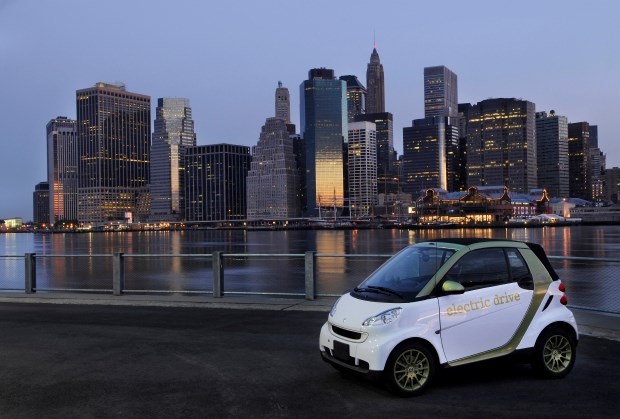The smart money is on electric cars these days. North America's smallest car, the Smart ForTwo, is poised to jump on the bandwagon as well, with plans for an electric drive version - the Smart ED (Electric Drive) - sometime this fall.
In order to generate interest in the new car, the company has been touring the country with some test cars. I got a chance to take one home for the weekend to briefly get a taste of the future.
Smart has been busy over the past few years developing an electric car. The car I drove is what Smart considers its second-generation car.
The first-generation cars began field testing in 2007. In 2011, Smart imported 250 second-generation cars to the United States (similar to my tester).
The third-generation car will be the model available to the public in 30 world markets.
The ED is a battery electric vehicle (BEV). Its body is that of a regular Smart car.
Instead of a three cylinder gas engine, the ED is powered by a 30-kilowatt motor.
What's unusual about this electric motor is the fact it produces 27 horsepower most of the time (constant power), but that can be increased to 40 hp (peak power) for up to two minutes. What this means is that the engine operates in its most fuel-efficient mode most of the time with the ability to tap into extra power as needed. It's like driving continuously in eco mode in a hybrid.
Tapping into the ED's maximum potential is simple - it simply requires a hard stomp on the "gas" pedal. Even at its peak output there isn't much power - on paper.
The lack of power isn't apparent in the city - Smart claims a 0 to 60 km/h time of 6.5 seconds - about the same as the gasoline car. In stop-and-go traffic, 27 hp is more than enough.
But get the car on the highway and the story changes quickly. A tester in another publication measured 0 to 100 km/h at an agonizingly slow 23 seconds. I am not surprised. Coincidentally, the top speed of to car is 102 km/h.
Suffice it to say, merging with highway traffic was downright scary. It's easy to see why Smart decided not to market this car in North America.
Smart says the power issue will be addressed by the new car this fall. The third-generation car will boast a respectable 35 kW constant and 55 kW peak output motor that delivers 75 hp and 96 lb.-ft. of torque.
The car's 0-to-100-km/h times will now drop to a respectable 13 seconds. Top speed will be in excess of 120 km/h, on par with the gas Smart.
The current car's lithium-ion battery is rated at 16.5 kWh, which gives the ED a range of about 135 km. The battery size will increase to 17.6 kWh this fall and its range will increase to 140 km.
Keep in mind this is calculated according to the New European Driving Cycle standard. The EPA rates the current car's range at 101 kilometres.
It takes eight hours to fully charge the car with a 240v charger. Smart points out a charge from 20 to 80 per cent takes only three hours.
The U.S. EPA gives the current Smart ED a fuel economy number of 2.5 litres equivalent/100 km in the city and 3.0 on the highway (that's 113 mpg city and 94 mpg highway).
Although that is an impressive number, it's less fuel efficient than the Nissan Leaf, which gets 2.2 city and 2.6 highway. The Smart ED is neck-and-neck with the extended-range Chevrolet Volt.
Mind you, like the engine, the economy numbers will probably change by the fall as well.
A bigger change this fall is the availability of a direct-current quick charger socket. This Level 3 connector can charge an electric car's battery to 80 per cent in as little as 20 minutes. It is not known if the connector will be standard equipment (like the Mitsubishi i MiEV) or optional (like the Leaf).
The Smart ED feels heavier than the regular Smart. The batteries add 70 kilograms to the Smart car (890 versus 820). The pack is located under the floor in the centre of the car. Hitting potholes produces louder thunks due to the added weight.
The interior is much the same as a regular ForTwo, with two instruments pods on the dash.
One shows the charge status of the battery and the other the car's energy usage.
The new car will have a smartphone app that allows owners to visualize their range on an interactive map and a list of public charging stations.
The Smart ED will be available as a two-door coupe and two-door convertible. When it arrives in September it will be the smallest mass-produced electric vehicle on the market. There has been no mention of what the Smart ED will sell for. The regular Smart starts at $14,350 for the coupe and $20,500 for the cabriolet.



